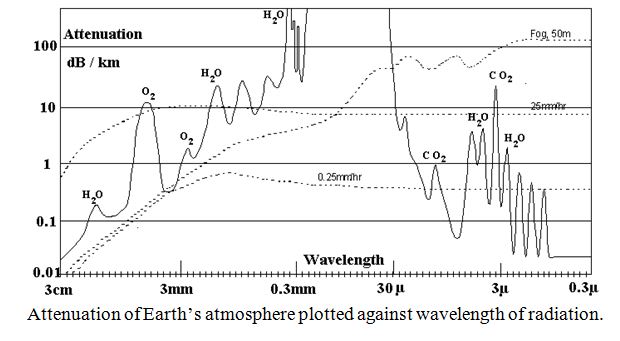| Back |
|---|
The atmosphere through which we transmit our radio waves is not completely transparent to radio waves. It varies in density, which falls with increasing altitude, causing a slight bending of the propagation path towards the earth. This results in the effective radius of the earth at radio wavelengths being approximately 4/3 of its true radius of about 4000 miles. Also, the atmosphere consists of a mixture of gasses, the molecules of which resonate, and therefore absorb, (like little absorption wavemeters), at many different frequencies. Fortunately, for most Radio Amateurs, the frequencies at which absorption occurs are well above the usual DX communication frequencies.
One sometimes hears comment, particularly from VHF operators, to the effect that weather conditions such as rain or fog are attenuating their signals, and producing a poorer report than on some previous occasion, but in reality, atmospheric attenuation is almost certainly not to blame. It is far more likely that a change in the refractive index of air with height, such as an inversion layer, is responsible. This causes an additional slight bending of the wave path. If the bending is in a downward direction, the waves follow the curved surface of the earth more easily, giving rise to a “lift” condition, and vice versa.
It is only at microwave frequencies that atmospheric attenuation becomes significant, even in the presence of rain or fog. This can be seen on the attached graph which requires some explanation. Both scales cover a huge range. The X axis goes from 3 cm, (a typical “Airborne Radar” or “weather radar” wavelength), to 0.3 micrometer, the near ultra violet. Note the “optical window” extending from 0.7? to 0.4? on the extreme right of the graph. Although not shown on the graph, the atmosphere becomes relatively opaque again beyond 0.3µ. This is fortunate as it protects us from the more damaging shorter wave ultra violet wavelengths.
The Y axis is one of fierce attenuation, as it is logarithmic in dBs. It goes from 0.01 dB per kilometre, i.e. absolutely negligible, to well over 100 dB per kilometre, or a dB every 10 metres. Actually there are wavelengths both in the infra-red and far ultra violet which are attenuated by many dBs per metre but are completely off the top of the scale on this graph. The solid line is for normal clear air at sea level and some of the molecular absorption bands due to water vapour, oxygen and carbon dioxide are marked. The three dotted lines show additional absorption which must be added to that of clear air for the special cases of thick fog with a visibility of 50 metres, light drizzle at 0.25 mm per hour and torrential rain at 25 mm per hour. Even the latter causes practically no attenuation at wavelength longer than about 10 cms, although in the radar case such rain causes considerable “back scatter” which may obscure small airborne targets.
Very high atmospheric attenuation can be put to good use in some applications. For example, collision avoidance radars fitted to cars are currently being worked on. These are intended to control one’s distance from the car in front depending on one’s own speed. The maximum range of such a radar doesn’t need to exceed about 100 metres. In fact it would be a definite disadvantage if it did because it would then interfere with other similar radars on other cars operating near the same frequency. Similarly, it has been proposed that military aircraft, operating at high altitude could communicate securely with one another at frequencies of very high atmospheric attenuation, but their conversations would be undetectable on the ground.

John, G0NVZ
| Back |
|---|
